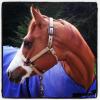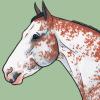White Patterns article posted
Forums
I have finished the white pattern article.
Yes there are ones with very
Yes there are ones with very minimal white, just toe tips and maybe and little spot on the neck, but it is a no no for the breed standard for them to have no white, they must have some white. I personally like the minimal white ones because I like that the tan shows more with what ever the base color is, because with more tan showing and the white it is very stiking. Hunters however prefer the piebalds as they are more easily spotted in the feild. I like to breed a blanket back or mostly solid dog to a mostly white piebald and then I get both and everything in between.
That looks alot like what
That looks alot like what boxers have and if so it wouldn't be a minimal piebald but rather Irish spotting. If it is then the genes involved would be S, s[sup]i[/sup], and s[sup]p[/sup]. The S would be the solids or very min white (if you subscribe to the theory of incomplete melanocytes migration). s[sup]i[/sup]s[sup]i[/sup] would be Irish Spotting with white under sides. s[sup]i[/sup]s[sup]p[/sup] would be the middle of the road patterns (probably your blanket back) and s[sup]p[/sup]s[sup]p[/sup] would be the extreme white and the piebald.
Have you ever seen a very minimal white bred to a Irish spotting like the last one you posted?
Here is a picture of my
Here is a picture of my friend Renae's "Sunset Acres Lily of the Vally", she is a very minimal white, Pearl/tan/white Rat terrier.
Not right off the the top of
Not right off the the top of my head. I have never bred 2 like that, but Renae might have. She had Lily's mom who was a blue/tan/white also very minimal white, and she had quite a few litter's from her but I think she mated her mostly with Tequila's dad Striker who was a Choc/tan/white Piebald. But I know a lot of Rat terrier sites, I'll see if I can find somthing. There might even be some examples on Renae's site I just have to look and see.
Here we go she sent me the
Here we go she sent me the link to her Lily & Tank puppies.......
I finally got a chance to
I finally got a chance to take a look at these. It's very interesting. Looking (and assuming the current theories) the sire and dam would both have to carry a s[sup]p[/sup]. So I'm guess the dam is Ss[sup]p[/sup] and the sire would have to be s[sup]i[/sup]s[sup]p[/sup]. I think this would account for all the pups. The low whites would be Ss[sup]p[/sup] (or perhaps s[sup]i[/sup]) like the dam the one blanket back would be s[sup]i[/sup]s[sup]p[/sup] like the sire and the piebald one would be s[sup]p[/sup]s[sup]p[/sup].
Sorry it took me so long we've been driving to midnight every night until tonight.
Ok let me see if I can make
Ok let me see if I can make it a bit easier. According to the inheritance studies done in boxers there are 3 alleles to white patterns. S (solid), s[sup]i[/sup], and s[sup]p[/sup]. In boxers s[sup]i[/sup] and s[sup]p[/sup] are respectively Irish spotting and piebald. They are both recessive to S meaning that if a dog has an S allele then neither s[sup]i[/sup] or s[sup]p[/sup] will express but they can work together meaning that if a dog has an s[sup]i[/sup] and an s[sup]p[/sup] allele they will have more white than if they were s[sup]i[/sup]s[sup]i[/sup] (which would be an Irish spotting pattern) but less white than if they were s[sup]p[/sup]s[sup]p[/sup] (which would be a piebald pattern). In these pups I think both of the parents must have a s[sup]p[/sup] allele since one of the pups is an obvious piebald (s[sup]p[/sup]s[sup]p[/sup]). Since the dam has so little white, and none of the pups has an obvious Irish Spotting pattern, I'm assuming that she is Ss[sup]p[/sup] and the sire is s[sup]i[/sup] s[sup]p[/sup]. This seems to fit all the pups in that we have Ss[sup]p[/sup] (or perhaps Ss[sup]i[/sup]) to account for the low white pups, s[sup]i[/sup]s[sup]p[/sup] to account for the blanket back pup like the sire and s[sup]p[/sup]s[sup]p[/sup] pups that are piebald.
Hope this helps a bit,
Daylene
You might want to add the
You might want to add the Panda mutation that was found in German Shepherds.
[quote]A unique coat color pattern, termed Panda, occurs in a single bloodline of German Shepherd Dogs. With the help of the founding breeder, Ms. Cindy McCann of Ohio, we have analyzed the DNA of Panda dogs and their non-Panda littermates using modern genetic tools. We have proven without a doubt the following
-The coat color pattern stems from a spontaneous mutation; it was not introduced from another breed or population.
-The de novo mutation occurred in the Sire’s germ line, and was then passed down to his daughter, who was the only offspring of that sire to show the distinguishing markings.
-In subsequent generations, the Panda pattern has exhibited an autosomal dominant mode of inheritance, consistent with the action of a single gene acting with full penetrance.
-No discernible health affects have been observed in these dogs, though a double Panda dog has not yet been produced.
As the principal investigator of this study, I would be delighted to answer questions by breeders and owners who are interested in the genetics and biology of this coat color pattern. I can be contacted at:
Mark Neff, Ph.D.
VGL Canine Genetics[/quote]
You can see a picture of one here:
http://www.gallantwatchkennels.com/abou…



I know I get the piebalds in
I know I get the piebalds in my Rat terriers(first 3 pics)and we call the ones marked like rodeo a blanket back(4th pic), and then if the color go's further down the leg then it would be a tuxedo(Rodeo actually has one sleave like a tux)but that is referring to the color not the white pattern. Would the first 3 pics of my dogs all be considered piebald and then Rodeo's pattern would that be the Irish markings or do they have to have the blazed face?